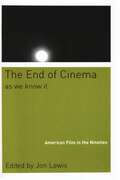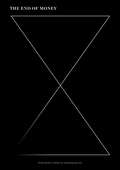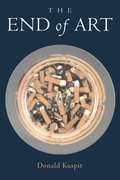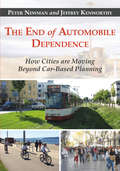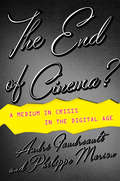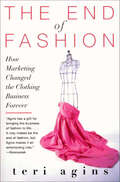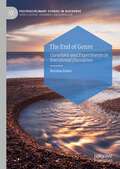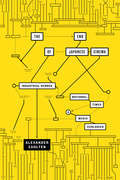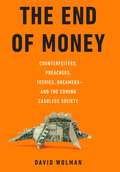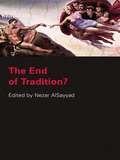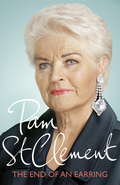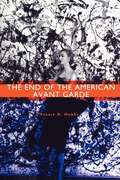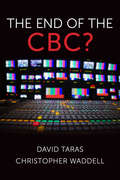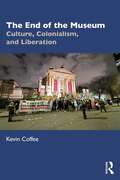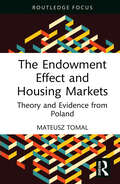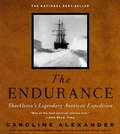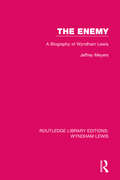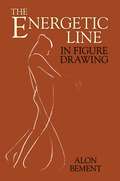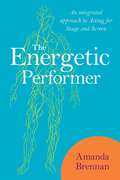- Table View
- List View
The End Of Cinema As We Know It: American Film in the Nineties
by Jon LewisThirty-four essays that take a serious look at the state of modern cinemaAlmost half a century ago, Jean-Luc Godard famously remarked, "I await the end of cinema with optimism." Lots of us have been waiting forand wondering aboutthis prophecy ever since. The way films are made and exhibited has changed significantly. Films, some of which are not exactly "films" anymore, can now be projected in a wide variety of wayson screens in revamped high tech theaters, on big, high-resolution TVs, on little screens in minivans and laptops. But with all this new gear, all these new ways of viewing films, are we necessarily getting different, better movies? The thirty-four brief essays in The End of Cinema as We Know It attend a variety of topics, from film censorship and preservation to the changing structure and status of independent cinemafrom the continued importance of celebrity and stardom to the sudden importance of alternative video. While many of the contributors explore in detail the pictures that captured the attention of the nineties film audience, such as Jurassic Park, Eyes Wide Shut, South Park: Bigger, Longer and Uncut, The Wedding Banquet, The Matrix, Independence Day, Gods and Monsters, The Nutty Professor, and Kids, several essays consider works that fall outside the category of film as it is conventionally definedthe home "movie" of Pamela Anderson and Tommy Lee's honeymoon and the amateur video of the LAPD beating of Rodney King. Examining key films and filmmakers, the corporate players and industry trends, film styles and audio-visual technologies, the contributors to this volume spell out the end of cinema in terms of irony, cynicism and exhaustion, religious fundamentalism and fanaticism, and the decline of what we once used to call film culture. Contributors include: Paul Arthur, Wheeler Winston Dixon, Thomas Doherty, Thomas Elsaesser, Krin Gabbard, Henry Giroux, Heather Hendershot, Jan-Christopher Hook, Alexandra Juhasz, Charles Keil, Chuck Klienhans, Jon Lewis, Eric S. Mallin, Laura U. Marks, Kathleen McHugh, Pat Mellencamp, Jerry Mosher, Hamid Naficy, Chon Noriega, Dana Polan, Murray Pomerance, Hillary Radner, Ralph E. Rodriguez, R.L. Rutsky, James Schamus, Christopher Sharrett, David Shumway, Robert Sklar, Murray Smith, Marita Sturken, Imre Szeman, Frank P. Tomasulo, Maureen Turim, Justin Wyatt, and Elizabeth Young.
The End Of Money
by David Weiss Dieter Roelstraete Peter Fischli Donatien Grau Dessislava DimovaThis digital publication (with a limited print edition of 100) accompanies the exhibition The End of Money (22 May - 7 August 2011).
The End of Art
by Donald KuspitIn The End of Art, Donald Kuspit argues that art is over because it has lost its aesthetic import. Art has been replaced by 'postart', a term invented by Alan Kaprow, as a new visual category that elevates the banal over the enigmatic, the scatological over the sacred, cleverness over creativity. Tracing the demise of aesthetic experience to the works and theory of Marcel Duchamp and Barnett Newman, Kuspit argues that devaluation is inseparable from the entropic character of modern art, and that anti-aesthetic postmodern art is its final state. In contrast to modern art, which expressed the universal human unconscious, postmodern art degenerates into an expression of narrow ideological interests. In reaction to the emptiness and stagnancy of postart, Kuspit signals the aesthetic and human future that lies with the New Old Masters. The End of Art points the way to the future for the visual arts.
The End of Automobile Dependence: How Cities are Moving Beyond Car-Based Planning
by Jeffrey Kenworthy Peter NewmanCities will continue to accommodate the automobile, but when cities are built around them, the quality of human and natural life declines. Current trends show great promise for future urban mobility systems that enable freedom and connection, but not dependence. We are experiencing the phenomenon of peak car use in many global cities at the same time that urban rail is thriving, central cities are revitalizing, and suburban sprawl is reversing. Walking and cycling are growing in many cities, along with ubiquitous bike sharing schemes, which have contributed to new investment and vitality in central cities including Melbourne, Seattle, Chicago, and New York. We are thus in a new era that has come much faster than global transportation experts Peter Newman and Jeffrey Kenworthy had predicted: the end of automobile dependence. In The End of Automobile Dependence, Newman and Kenworthy look at how we can accelerate a planning approach to designing urban environments that can function reliably and conveniently on alternative modes, with a refined and more civilized automobile playing a very much reduced and manageable role in urban transportation. The authors examine the rise and fall of automobile dependence using updated data on 44 global cities to better understand how to facilitate and guide cities to the most productive and sustainable outcomes. This is the final volume in a trilogy by Newman and Kenworthy on automobile dependence (Cities and Automobile Dependence in 1989 and Sustainability and Cities: Overcoming Automobile Dependence in 1999). Like all good trilogies this one shows the rise of an empire, in this case that of the automobile, the peak of its power, and the decline of that empire.
The End of Cinema?
by André Gaudreault Timothy Barnard Philippe MarionIs a film watched on a video screen still cinema? Have digital compositing, motion capture, and other advanced technologies remade or obliterated the craft? Rooted in their hypothesis of the "double birth of media," André Gaudreault and Philippe Marion take a positive look at cinema's ongoing digital revolution and reaffirm its central place in a rapidly expanding media landscape.The authors begin with an overview of the extreme positions held by opposing camps in the debate over cinema: the "digitalphobes" who lament the implosion of cinema and the "digitalphiles" who celebrate its new, vital incarnation. Throughout, they remind readers that cinema has never been a static medium but a series of processes and transformations powering a dynamic art. From their perspective, the digital revolution is the eighth major crisis in the history of motion pictures, with more disruptions to come. Brokering a peace among all sides, Gaudreault and Marion emphasize the cultural practice of cinema over rigid claims on its identity, moving toward a common conception of cinema to better understand where it is headed next.
The End of Cinema?: A Medium in Crisis in the Digital Age (Film and Culture Series)
by André Gaudreault Philippe MarionIs a film watched on a video screen still cinema? Have digital compositing, motion capture, and other advanced technologies remade or obliterated the craft? Rooted in their hypothesis of the "double birth of media," André Gaudreault and Philippe Marion take a positive look at cinema's ongoing digital revolution and reaffirm its central place in a rapidly expanding media landscape.The authors begin with an overview of the extreme positions held by opposing camps in the debate over cinema: the "digitalphobes" who lament the implosion of cinema and the "digitalphiles" who celebrate its new, vital incarnation. Throughout, they remind readers that cinema has never been a static medium but a series of processes and transformations powering a dynamic art. From their perspective, the digital revolution is the eighth major crisis in the history of motion pictures, with more disruptions to come. Brokering a peace among all sides, Gaudreault and Marion emphasize the cultural practice of cinema over rigid claims on its identity, moving toward a common conception of cinema to better understand where it is headed next.
The End of Fashion: How Marketing Changed the Clothing Game Forever
by Teri AginsA Wall Street Journal reporter’s account of the radical transformation of the fashion industry, “filled with insider details” (Library Journal).The time when fashion was defined by French designers whose clothes could be afforded only by the elite has ended. Now designers take their cues from mainstream consumers and creativity is channeled more into mass-marketing clothes than into designing them. In The End of Fashion, Wall Street Journal reporter Teri Agins astutely explores this seminal change, laying bare all aspects of the fashion industry from manufacturing, retailing, and licensing to image making and financing. Here as well are fascinating insider vignettes that show Donna Karan fighting with financiers, the rivalry between Ralph Lauren and Tommy Hilfiger, and the commitment to haute couture that sent Isaac Mizrahi’s business spiraling.“The End of Fashion rips into the seamy underbelly of a world where marketing is king, and often the emperor has no clothes.” —Vanity Fair“Essential reading not just for ‘fashionistas,’ but anyone interested in how business really works—or fails—in this dizzying world of art, culture, entertainment, and finance.” —James B. Stewart, Pulitzer Prize winner and New York Times–bestselling author of Unscripted“Compelling.” —Publishers Weekly “It ought to be required reading for people who think they might like to be clothing designers.” —The New York Times
The End of Genre: Curations and Experiments in Intentional Discourses (Postdisciplinary Studies in Discourse)
by Brenton FaberThis book explores early new critical debates about intention, tracing how and why intention was dismissed across much humanities scholarship, and how it can be revisited and made relevant as a key formative, evaluative, and ethical concept. The author argues that the academic disinterest in intention occurred simultaneously as genre criticism and later the rhetorical interest in genre came into its own. Genre became a way to simultaneously elide and naturalize intention. The book elaborates on the pedagogical, ethical, and empirical consequences naturalizing intention through genre has had for rhetorical studies and it offers a new term, “curations” to identify discursive forms, actions, and intentions working simultaneously. Finally, he also examines the gap between the humanities and STEM fields and shows specific ways scientists and engineers have called for the humanities to become more invested in intention as both a critical and an operational concept. This book will be of interest to students and scholars of discourse studies and critical discourse analysis, rhetoric and professional communication, including those in fields such as medicine, engineering, STS and business studies.
The End of Japanese Cinema: Industrial Genres, National Times, and Media Ecologies
by Alexander ZahltenIn The End of Japanese Cinema Alexander Zahlten moves film theory beyond the confines of film itself, attending to the emergence of new kinds of aesthetics, politics, temporalities, and understandings of film and media. He traces the evolution of a new media ecology through deep historical analyses of the Japanese film industry from the 1960s to the 2000s. Zahlten focuses on three popular industrial genres: Pink Film (independently distributed softcore pornographic films), Kadokawa (big-budget productions as part of a transmedia strategy), and V-Cinema (direct-to-video films). He examines the conditions of these films' production to demonstrate how the media industry itself becomes part of the politics of the media text and to highlight the complex negotiation between media and politics, culture, and identity in Japan. Zahlten points to a different history of film, one in which a once-powerful film industry transformed into becoming only one component within a complex media-mix ecology. In so doing, Zahlten opens new paths for uncovering similar broad processes in other large media societies. A Study of the Weatherhead East Asian Institute, Columbia University
The End of Money
by David WolmanFor ages, money has meant little metal disks and rectangular slips of paper. Yet the usefulness of physical money--to say nothing of its value--is coming under fire as never before. Intrigued by the distinct possibility that cash will soon disappear, author and Wired contributing editor David Wolman sets out to investigate the future of money. . . and how it will affect your wallet. Wolman begins his journey by deciding to shun cash for an entire year--a surprisingly successful experiment (with a couple of notable exceptions). He then ventures forth to find people and technologies that illuminate the road ahead. In Honolulu, he drinks Mai Tais with Bernard von NotHaus, a convicted counterfeiter and alternative-currency evangelist whom government prosecutors have labeled a domestic terrorist. In Tokyo, he sneaks a peek at the latest anti-counterfeiting wizardry, while puzzling over the fact that banknote forgers depend on society's addiction to cash. In a downtrodden Oregon town, he mingles with obsessive coin collectors--the people who are supposed to love cash the most, yet don't. And in rural Georgia, he examines why some people feel the end of cash is Armageddon's warm-up act. After stops at the Digital Money Forum in London and Iceland's central bank, Wolman flies to Delhi, where he sees first-hand how cash penalizes the poor more than anyone--and how mobile technologies promise to change that. Told with verve and wit, The End of Money explores an aspect of our daily lives so fundamental that we rarely stop to think about it. You'll never look at a dollar bill the same again.
The End of Money
by Juan A. GaitánThis book has been conceived as a parallel reflection to the exhibition The End of Money . It includes a number of contributions that extend the exhibition proper beyond its self-contained existence in the gallery space. In this respect, it is also a vehicle through which the exhibition can find different discursive grounds for exploring the theme of the end of money, both as a literary and as an iconographic motif.
The End of Tradition?
by Nezar AlSayyadRooted in real world observations, this book questions the concept of tradition - whether contemporary globalization will prove its demise or whether there is a process of simultaneous ending and renewing. In his introduction, Nezar Alsayyad discusses the meaning of the word 'tradition' and the current debates about the 'end of tradition'. Thereafter the book is divided into three parts. The three chapters in part I explore the inextricable link between 'tradition' and 'modern', revealing the geopolitical implications of this link. Part II looks at tradition as a process of invention and here the three chapters are all concerned with the making of landscapes and landscape myths, showing how the spectacle of history can be aestheticized and naturalized. Finally, Part III shows how traditionis a regime, programmed and policed and how it has been deployed, resisted, and reworked through hegemonic struggles that seek to create both built environments and citizen-subjects.
The End of an Earring
by Pam St ClementIn January 2012, one of EastEnders' longest-serving and best-loved characters breathed her last when Pat Butcher succumbed to cancer. Her departure from the show gave actress Pam St Clement time to reflect, not only on almost 26 years playing a role that she loved, but also on her whole life.Pam's mother died when she was a baby, leaving her with a father whose life didn't really have space for a child. What followed was an itinerant childhood, with various stepmothers and foster families, before an advertisement in The Lady took 11-year-old Pamela to the farm in Devon that was to become her true home, with the 'aunts' who became her surrogate parents. Time on the farm at Dartmoor, where she discovered her love of animals, alternated with life at The Warren boarding school in West Sussex, where she discovered her passion for acting.On leaving school, Pam was unsure of what direction to take but gradually realised that acting was what she wanted to do with her life. So, in 1966, Pam took up a place at drama school. Pam settled in London and worked on stage and television throughout the sixties and seventies, before her first appearance on EastEnders in 1986 and the offer of a permanent role a few months later.This memoir is far more than simply an actor's tale. Quite apart from her fascinating and unique childhood, Pam also recalls her involvement in the women's movement of the 1970s, her lifelong love of animals and the worries about her weight that have dogged her since her teenage years. It is also a tribute to Pat Butcher, for whom Pam retains a huge affection.This incredibly warm memoir reveals the woman behind the popular EastEnders' character, a woman who, apart perhaps from her earrings, couldn't be more different from Pat.
The End of an Earring
by Pam St ClementIn January 2012, one of EastEnders' longest-serving and best-loved characters breathed her last when Pat Butcher succumbed to cancer. Her departure from the show gave actress Pam St Clement time to reflect, not only on almost 26 years playing a role that she loved, but also on her whole life.Pam's mother died when she was a baby, leaving her with a father whose life didn't really have space for a child. What followed was an itinerant childhood, with various stepmothers and foster families, before an advertisement in The Lady took 11-year-old Pamela to the farm in Devon that was to become her true home, with the 'aunts' who became her surrogate parents. Time on the farm at Dartmoor, where she discovered her love of animals, alternated with life at The Warren boarding school in West Sussex, where she discovered her passion for acting.On leaving school, Pam was unsure of what direction to take but gradually realised that acting was what she wanted to do with her life. So, in 1966, Pam took up a place at drama school. Pam settled in London and worked on stage and television throughout the sixties and seventies, before her first appearance on EastEnders in 1986 and the offer of a permanent role a few months later.This memoir is far more than simply an actor's tale. Quite apart from her fascinating and unique childhood, Pam also recalls her involvement in the women's movement of the 1970s, her lifelong love of animals and the worries about her weight that have dogged her since her teenage years. It is also a tribute to Pat Butcher, for whom Pam retains a huge affection.This incredibly warm memoir reveals the woman behind the popular EastEnders' character, a woman who, apart perhaps from her earrings, couldn't be more different from Pat.
The End of the American Avant Garde: American Social Experience Series (The\american Social Experience Ser.)
by Stuart D. Hobbs"By 1966, the composer Virgil Thomson would write, "Truth is, there is no avant-garde today." How did the avant garde dissolve, and why? In this thought-provoking work, Stuart D. Hobbs traces the avant garde from its origins to its eventual appropriation by a conservative political agenda, consumer culture, and the institutional world of art.
The End of the CBC?
by David Taras Christopher WaddellThe End of the CBC? is about three overlapping crises: the crisis that has enveloped the CBC, the crisis of news, and the crisis of democracy. They are all the result to some degree of the vast changes that have overtaken and consumed the media world in the last ten to fifteen years. The emergence of platforms such as Google, Facebook, Twitter, and Netflix, the hyper-targeting of individual users through data analytics, the development of narrow online identity communities, and the rise of an attention economy that makes it more and more difficult for any but the most powerful media organizations to be noticed, have changed the media landscape in dramatic ways. The effects on the CBC and on other Canadian media organizations have been shattering. Describing the failure of successive governments to address problems faced by the public broadcaster, this book explains how the CBC lost its place in sports, drama, and entertainment. Taras and Waddell propose a way forward for the CBC – one in which the corporation concentrates its resources on news and current affairs and re-establishes a reputation for depth and quality.
The End of the Museum: Culture, Colonialism and Liberation
by Kevin CoffeeThis provocative book challenges frequently voiced assertions regarding museums as necessary and valued modern institutions. It raises fundamental, existential questions about contemporary museums as products of the modern colonial world order.Drawing on practical examples of collecting and exhibiting, theoretical research, and critique from diverse countries across the globe, including Chile, India, Korea, the Netherlands, Nigeria, Palestine, Portugal, Sri Lanka and the United States, this book moves beyond the conventional Eurocentric museological framework. This book synthesizes contemporary critiques of museums, while arguing that societies need the sociocultural examinations that museums are capable of facilitating and that radical transformations of "the museum" are fraught with difficulty, but also possible and necessary. Ultimately, Coffee argues that museums can only be future orientated if they are transformed into agents of social justice and inclusion, divestors of illicit collections, and proponents of a liberatory ethic, opposing neo-colonialism in all of its forms. During that transformative process, as this book demonstrates, museum practice and museum theory must also be transformed.The End of the Museum: Culture, Colonialism, and Liberation will appeal to students, researchers, and practitioners interested in a critical examination of museum work and theory.
The End of the Village: Planning the Urbanization of Rural China (Globalization and Community #33)
by Nick R. SmithHow China&’s expansive new era of urbanization threatens to undermine the foundations of rural life Since the beginning of the twenty-first century, China has vastly expanded its urbanization processes in an effort to reduce the inequalities between urban and rural areas. Centered on the mountainous region of Chongqing, which serves as an experimental site for the country&’s new urban development policies, The End of the Village analyzes the radical expansion of urbanization and its consequences for China&’s villagers. It reveals a fundamental rewriting of the nation&’s social contract, as villages that once organized rural life and guaranteed rural livelihoods are replaced by an increasingly urbanized landscape dominated by state institutions. Throughout this comprehensive study of China&’s &“urban–rural coordination&” policy, Nick R. Smith traces the diminishing autonomy of the country&’s rural populations and their subordination to larger urban networks and shared administrative structures. Outside Chongqing&’s urban centers, competing forces are at work in reshaping the social, political, and spatial organization of its villages. While municipal planners and policy makers seek to extend state power structures beyond the boundaries of the city, village leaders and inhabitants try to maintain control over their communities&’ uncertain futures through strategies such as collectivization, shareholding, real estate development, and migration.As China seeks to rectify the development crises of previous decades through rapid urban growth, such drastic transformations threaten to displace existing ways of life for more than 600 million residents. Offering an unprecedented look at the country&’s contentious shift in urban planning and policy, The End of the Village exposes the precarious future of rural life in China and suggests a critical reappraisal of how we think about urbanization.
The Endings: Photographic Stories of Love, Loss, Heartbreak, and Beginning Again
by Jessica Ennis Caitlin CronenbergFeaturing some of today's most beloved actors, these piercing photographic vignettes capture female characters in the throes of powerful emotional transformations. Photographer Caitlin Cronenberg and art director Jessica Ennis collected stories of heartbreak, relationship endings, and new beginnings—fictional but often inspired by real life—and set out to convey the raw emotions that are exposed in those most vulnerable of states. Collaborating with celebrated talents such as Julianne Moore, Keira Knightley, and Gugu Mbatha-Raw, Cronenberg and Ennis developed each character, built her world, and then photographed as she lived the role before the camera. The resulting collection is a bold look at the experience of losing or leaving love and will speak to anyone who appreciates art, photography, and the strength of facing emotional depths head-on.
The Endless Periphery: Toward a Geopolitics of Art in Lorenzo Lotto's Italy (Louise Smith Bross Lecture Series)
by Stephen J. CampbellWhile the masterpieces of the Italian Renaissance are usually associated with Italy’s historical seats of power, some of the era’s most characteristic works are to be found in places other than Florence, Rome, and Venice. They are the product of the diversity of regions and cultures that makes up the country. In Endless Periphery, Stephen J. Campbell examines a range of iconic works in order to unlock a rich series of local references in Renaissance art that include regional rulers, patron saints, and miracles, demonstrating, for example, that the works of Titian spoke to beholders differently in Naples, Brescia, or Milan than in his native Venice. More than a series of regional microhistories, Endless Periphery tracks the geographic mobility of Italian Renaissance art and artists, revealing a series of exchanges between artists and their patrons, as well as the power dynamics that fueled these exchanges. A counter history of one of the greatest epochs of art production, this richly illustrated book will bring new insight to our understanding of classic works of Italian art.
The Endowment Effect and Housing Markets: Theory and Evidence from Poland (Routledge Studies in International Real Estate)
by Mateusz TomalThis book aims to provide a comprehensive analysis of the so-called “endowment effect” in the housing market. In a nutshell, the phenomenon of overvaluing things we own which was first conceptualised in 1980 and has since been one of the most studied behavioural biases in economics.The first chapter presents a systematic review of the literature on the endowment effect in the housing market, together with the identification of research gaps to be filled by other researchers. The second chapter aims to propose a theoretical model explaining the strength of the endowment effect in sales and rental housing markets by primary and secondary markets. The last chapter presents the results of empirical research on the endowment effect in the Polish housing market, testing the model presented in Chapter 2. The chapters can be read together or independently by researchers, students, and policymakers interested in behavioural economics in housing and real estate. For policymakers, the book can be extremely useful as the endowment effect can create friction in the housing market because of a mismatch between the price demands of sellers and buyers, especially in countries where the level of market professionalisation is low (such as Poland). Thanks to the empirical research contained in this book, it will be possible to identify specific market segments where the endowment effect may be particularly elevated – on such segments, policymakers should introduce actions contributing to the elimination of this behavioural bias.
The Endurance: Shackleton's Legendary Antarctic Expedition
by Caroline AlexanderIn August 1914, days before the outbreak of the First World War, the renowned explorer Ernest Shackleton and a crew of twenty-seven set sail for the South Atlantic in pursuit of the last unclaimed prize in the history of exploration: the first crossing on foot of the Antarctic continent. Weaving a treacherous path through the freezing Weddell Sea, they had come within eighty-five miles of their destination when their ship, Endurance, was trapped fast in the ice pack. Soon the ship was crushed like matchwood, leaving the crew stranded on the floes. Their ordeal would last for twenty months, and they would make two near-fatal attempts to escape by open boat before their final rescue. Drawing upon previously unavailable sources, Caroline Alexander gives us a riveting account of Shackleton's expedition--one of history's greatest epics of survival. And she presents the astonishing work of Frank Hurley, the Australian photographer whose visual record of the adventure has never before been published comprehensively. Together, text and image re-create the terrible beauty of Antarctica, the awful destruction of the ship, and the crew's heroic daily struggle to stay alive, a miracle achieved largely through Shackleton's inspiring leadership. The survival of Hurley's remarkable images is scarcely less miraculous: The original glass plate negatives, from which most of the book's illustrations are superbly reproduced, were stored in hermetically sealed canisters that survived months on the ice floes, a week in an open boat on the polar seas, and several more months buried in the snows of a rocky outcrop called Elephant Island. Finally Hurley was forced to abandon his professional equipment; he captured some of the most unforgettable images of the struggle with a pocket camera and three rolls of Kodak film. Published in conjunction with the American Museum of Natural History's landmark exhibition on Shackleton's journey, The Endurance thrillingly recounts one of the last great adventures in the Heroic Age of exploration--perhaps the greatest of them all.
The Enemy: A Biography of Wyndham Lewis (Routledge Library Editions: Wyndham Lewis #1)
by Jeffrey MeyersOriginally published in 1980 and nominated for the Duff Cooper Prize, this was the first biography of Wyndham Lewis and was based on extensive archival research and interviews. It narrates Lewis’ years at Rugby and the Slade, his bohemian life on the Continent, the creation of Vorticism and publication of Blast, and his experiences at Passchendaele, as well as his many love affairs, his bitter quarrels with Bloomsbury and the Sitwells, the suppressed books of the thirties, the evolution of his political ideas, his self-imposed exile in North America and creative resurgence during his final blindness. Jeffrey Meyers also describes Lewis’ relationships with Roy Campbell, D. H. Lawrence, Katherine Mansfield, T. E Lawrence, Hemingway, Huxley, Yeats, Auden, Spender, Orwell and McLuhan. As the self-styled Enemy emerges from the shadows, he is seen as an independent and courageous artist and one of the most controversial and stimulating figures in modern English art and literature.
The Energetic Line in Figure Drawing
by Alon BementWell-crafted and class-tested, this guide to figure drawing features a unique teaching method. It focuses on learning to draw complete figures prior to the study of individual components, and it stresses action figures rather than the customary static examples favored by most drawing and anatomy texts. Employing more text than typical art instruction books, it presents thirty figure drawing lessons and fifty-six drawings and figures. Each lesson includes detailed instructions on anatomical drawing, accompanied by visual examples of strokes, boxes, and measurements. Author Alon Bement taught art instruction to future art teachers at Columbia University and later founded the prestigious Maryland Institute of Art. His students included Georgia O'Keeffe, who regarded him as a mentor and major influence. Bement's nontraditional approach offers students at all levels an excellent opportunity to build their visual acuity and technical skills.
The Energetic Performer: An Integrated Approach to Acting for Stage and Screen
by Amanda BrennanA new approach to actor training by a senior teacher, this illustrated manual shows how to use the body to produce rich, varied and truthful performances. The approach, rooted in the Michael Chekhov Technique, integrates ancient Qigong knowledge with somatic psychology and western actor training methods to identify the links between physical shape, emotion and feeling in performance. Supporting and illustrating the text, extensive practical exercises developed through actor training classes provide techniques to tune and adapt the body in preparation for creative work. This book will enhance your understanding of the actor's craft, offering the opportunity to grow and advance your pre-existing skills. Warm ups and sequences of exercises will enable you to implement and fully understand this innovative approach. All of the work can be applied to live and screen performances.
